We are constantly bombarded with dire warnings about severe climate change, droughts, and the impending scarcity of vital resources. The narrative of water shortages is particularly pervasive, often serving to instill fear and urgency in the public. This fear-driven narrative benefits those who seek to consolidate power and control, allowing them to exert influence over one of our most essential resources: water. When water is framed as a scarce commodity, it becomes easier for powerful entities to monopolize it, controlling not only water access but also the food supply and, by extension, the population.
Manufactured Droughts and Mismanagement
In regions like California, we frequently hear about devastating droughts. However, water mismanagement plays a significant role in these crises. For example, during periods of supposed water scarcity, millions of gallons of water are often released into the ocean. Such practices exacerbate the appearance of drought and serve to justify restrictive water policies and exorbitant water prices. This manipulation of water resources underscores a broader agenda to control access to water, making it a valuable and, for some, a profitable commodity.

Drought as a Weapon
Is it merely mismanagement, or is drought being used as a weapon? Evidence suggests that droughts may be deliberately exacerbated for strategic purposes. Technological advancements have made it possible to induce rainfall through machines that have been around for decades. Cloud seeding, for instance, involves dispersing substances like silver iodide into the atmosphere to stimulate rain formation. Despite the existence of such technologies, their application remains limited, raising questions about whether droughts are being artificially maintained to benefit those in power.

Weather as a Weapon
The use of weather modification as a weapon is not just a theoretical concept; it has historical precedents. One of the most notable examples is Operation Popeye during the Vietnam War. From 1967 to 1972, the U.S. military used cloud seeding to extend the monsoon season over specific areas in Vietnam, Laos, and Cambodia. The objective was to disrupt enemy supply lines by making the Ho Chi Minh Trail impassable due to heavy rains and resulting floods.
Another example is the allegations of weather modification during the Cold War. Both the United States and the Soviet Union conducted experiments aimed at manipulating weather patterns for strategic advantages.
These activities were eventually curtailed by international agreements like the Environmental Modification Convention (ENMOD) in 1977, which supposedly prohibits the use of environmental modification techniques for hostile purposes. However, we have observed significant weather changes, especially after cloud seeding programs have been implemented globally, including in supposedly drought-stricken California.
What is Primary Water?
Amidst these concerns, it's essential to recognize the existence of primary water, a largely untapped resource that originates deep within the Earth's mantle.
Unlike surface water, which comes from precipitation and follows the hydrological cycle, primary water is formed through geological processes and emerges from deep within the Earth's crust. This water is pushed upwards through faults and fractures in the rock and is often found in isolated aquifers that have remained untouched by surface contamination.

The Suppressed Truth About Water Production
Mainstream narratives often fail to acknowledge the natural processes through which water is continuously produced deep within the Earth's mantle, known as primary water. Instead, the focus remains on the hydrological cycle of surface water, also referred to as the secondary water cycle. This cycle involves the continuous movement of water on, above, and below the Earth's surface, primarily through evaporation, condensation, precipitation, and runoff. The secondary water cycle perpetuates the idea of inevitable water scarcity, as it depends on external factors like weather patterns and climate. This omission conveniently supports the agendas of powerful entities who profit from controlling existing water resources, leaving the public unaware of the untapped, abundant water that lies beneath our feet.
The Largest Underground Ocean
In recent years, scientists have discovered what is believed to be the largest known reservoir of water deep within the Earth's mantle. This "underground ocean" was identified through seismic imaging and studies of mineral composition. In 2014, researchers from the University of Arizona and other institutions detected this vast reservoir located about 400 miles beneath the Earth's surface. This reservoir is primarily composed of ringwoodite, a high-pressure mineral that can contain significant amounts of water within its crystal structure.

The estimated volume of this underground ocean is immense, with some studies suggesting it could contain up to three times the volume of all the surface water on Earth. This discovery challenges traditional views of water scarcity and emphasizes that significant quantities of water exist far beneath the surface, potentially influencing global water resources.
What is Ringwoodite?
Ringwoodite is a mineral that forms under high-pressure conditions within the Earth's mantle. It is a key component in the transition zone between the upper and lower mantle, situated about 250 to 410 miles below the Earth's surface. Ringwoodite has a unique ability to incorporate water into its crystal lattice, making it an important indicator of deep-seated water reservoirs.
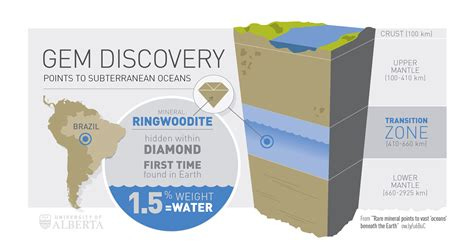
Ringwoodite typically appears as blue or greenish-blue crystals. It is often found in the form of small, transparent to translucent grains or aggregates. The mineral’s appearance can vary depending on the specific conditions under which it formed, but it generally has a glassy luster and can display a vitreous or resinous sheen. The blue or greenish hues of ringwoodite are due to trace elements and its crystal structure, which can influence the way it reflects light.
How Primary Water is Made
Primary water is created deep within the Earth through a combination of heat and pressure. As the Earth's mantle and crust undergo intense geological activity, hydrogen and oxygen atoms combine to form water molecules. This process occurs at great depths, far below the surface water and groundwater reservoirs. The high temperatures and pressures found in these deep geological formations cause chemical reactions that produce water. This newly formed water is then forced upwards through cracks, faults, and fissures in the Earth's crust, eventually accumulating in underground aquifers.
The Science Behind Primary Water
The concept of primary water dates back to the work of Dr. Stephan Riess, a geologist and mining engineer, who pioneered the idea in the mid-20th century. Riess believed, and had ample evidence to support, that the Earth produces water continuously through natural processes deep within its crust. He argued that primary water is an abundant, clean resource that could potentially solve many of the world's water scarcity issues. This water, as it emerges from deep underground, is free from pollutants commonly found in surface and groundwater, such as fluoride and chlorine.
Primary Water vs. Groundwater
Understanding the difference between primary water and the groundwater we often consume is crucial. Groundwater is derived from precipitation that infiltrates the soil and accumulates in aquifers. Over time, it can become contaminated with pollutants such as agricultural runoff, industrial chemicals, and additives like fluoride and chlorine used in water treatment processes. This results in groundwater often requiring extensive treatment to make it safe for consumption.

In contrast, primary water originates deep within the Earth's mantle, where it is insulated from surface pollutants. As a result, primary water is typically much purer, free from surface contaminants, and does not require the same level of treatment as groundwater. This makes primary water an incredibly valuable resource, especially in areas where clean drinking water is supposedly scarce.
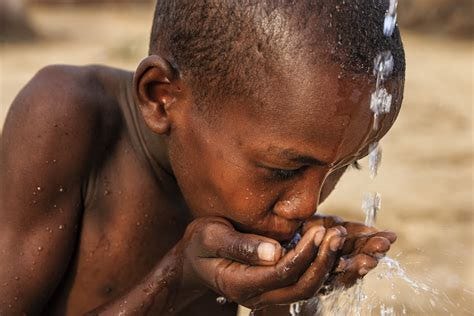
Primary Water Drilling Projects
Riess and his followers successfully drilled numerous primary water wells in arid regions, proving that this resource is not only real but also accessible. Some notable projects include:
Olancha, California: One of Riess's first successful wells provided fresh water to the local community. Desert Hot Springs, California: Showcased the potential of primary water to provide clean, abundant water in desert areas. Madras, Oregon: Where Riess found a significant source of primary water. Arizona and Nevada: Various successful wells demonstrated the viability of tapping primary water in arid regions. Libya's Great Man-Made River Project: Tapped into deep aquifers believed to be sources of primary water, supplying water to the population and agricultural projects.
Ownership and Control of Water Rights
The successful extraction of primary water leads us to a critical issue: ownership and control of water rights. In many regions, groundwater rights are owned by private landowners, corporations, or government entities. These rights can be bought, sold, and traded much like any other commodity. This system often leads to the consolidation of water rights in the hands of a few wealthy individuals and corporations, who can then control access to this vital resource.
The Role of Corporations: The Case of Nestlé
One of the most prominent examples of corporate control over water resources is Nestlé. Over the years, Nestlé has acquired extensive water rights across the globe, often buying up groundwater rights and controlling access to natural springs. This control allows the company to extract large quantities of water at minimal cost, which they then bottle and sell at a significant profit.

Nestlé's practices have often sparked controversy and criticism. In many instances, local communities have accused the company of depleting local water supplies, leaving residents with reduced access to clean water. For example, in California, Nestlé has faced backlash for continuing to extract water from drought-stricken regions, raising concerns about the long-term sustainability of such practices. Even more egregious is the situation in Flint, Michigan, where residents have struggled with hazardous water contaminated by lead while Nestlé continued to extract and bottle clean groundwater from the state selling it back to residents of Flint. This stark contrast highlights the inequality and injustice in water resource management.

Billionaires and Water Banks
The control of water resources by a wealthy few extends beyond Nestlé. In California, billionaire-controlled water banks have emerged as critical players in the state's water landscape. These water banks, essentially underground reservoirs where water is stored during wet years for use during dry periods, are privately managed and highly lucrative. The Resnick family, for instance, controls the Kern Water Bank, one of the largest in California. This water bank is crucial in a state where water scarcity is a recurring issue, yet its management and profits benefit only a select few.
Gateskeeping Our Water: Bill Gates' Control Over Critical Resources
Bill Gates, through his investment firm Gates Ventures and the Bill & Melinda Gates Foundation, has been strategically acquiring water rights in several key locations. His investments include significant water rights in the western United States, particularly in California and Arizona, where water scarcity is a pressing issue. His investments include substantial water rights in:
California: Gates Ventures controls significant water rights in the Central Valley, a major agricultural area suffering from chronic water shortages.
Arizona: Gates has acquired water rights in the Phoenix area and its surroundings, regions critical for both urban and agricultural needs.
Nevada: Gates has also invested in water rights in Nevada, an area facing severe water stress.
Oregon: Investments extend to various parts of Oregon, a state dealing with its own water management challenges.
These acquisitions have given Gates substantial influence over critical water resources in some of the most water-stressed regions of the United States.
In California, Gates Ventures acquiring water rights in the Central Valley, a major agricultural area facing chronic water shortages is questionable. These acquisitions give Gates considerable influence over a crucial resource in one of the most water-stressed regions in the country.
Similarly, in Arizona, Gates has invested in water rights that could impact water availability in both urban and rural areas.
Gates Ventures has funded companies and technologies aimed at enhancing water access and quality, including investments in Xylem, a company specializing in water technology and infrastructure. Although marketed as efforts to tackle water scarcity and improve sanitation, these investments raise concerns about control and access.

Gates' focus on developing advanced water purification technologies and promoting sustainable water management practices reflects a broader goal of leveraging innovation to address global water issues. However, this approach also highlights the potential for consolidating control over water resources, raising questions about the implications for public access and equity.

Bill Gates has positioned himself as a key player in addressing the global water crisis, but his methods have raised eyebrows. One of his most controversial initiatives involves promoting the treatment and recycling of sewage water for human consumption, a process that has been dubbed "poop water."
Gates has even showcased drinking this recycled water to demonstrate its safety. Additionally, he has funded projects to brew beer using treated sewage water, aiming to normalize the use of reclaimed wastewater. While these efforts are framed as innovative solutions to water scarcity, they also highlight the lengths to which Gates is willing to go to promote unconventional methods, raising questions about the underlying motives and long-term impacts of such practices.
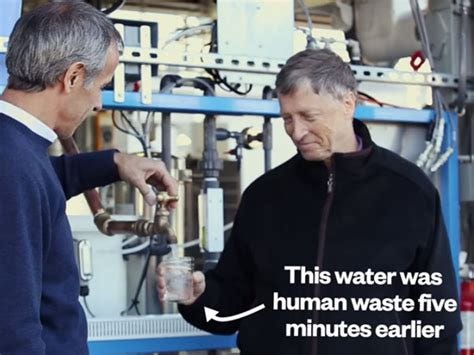
The integration of such technologies into city water supplies could consolidate control over water quality and access, amplifying concerns about the concentration of power and influence in the hands of a few. As Gates continues to expand his footprint in the water sector, it is essential to critically examine the implications of his investments on water accessibility, public health, and environmental “sustainability”. Are we the carbon these sociopaths are trying to get rid of?

Unseen Threats: Graphene Oxide in Water Systems and Beyond
Graphene oxide, lauded for its impressive filtration capabilities, is being covertly integrated into water systems, vaccines, and various other products without comprehensive safety testing.
In water systems, graphene oxide is often implemented in the form of graphene oxide foam, a material known for its supposed exceptional ability to absorb and remove contaminants from water. Additionally, graphene oxide-coated pipes are being used to enhance water quality by preventing biofilm formation and reducing contamination. These advanced technologies are said to efficiently clean water by trapping impurities at the nano-level, making them attractive solutions for improving water quality
However, the deployment of graphene oxide in water systems typically occurs without public awareness or adequate safety studies. Its presence in vaccines and other consumer goods has raised alarm due to the lack of transparent, long-term studies on its effects. The potential risks of graphene oxide include toxicity from nano-sized particles that can penetrate biological membranes and accumulate in organs. This widespread, unregulated use emphasizes the urgent need for rigorous testing and public disclosure to ensure safety and prevent unforeseen health and environmental consequences.
The Primary Water Institute
The Primary Water Institute, founded by supporters of Dr. Riess's work, like Pal Pauer, continues to explore and advocate for the utilization of primary water. The institute conducts research, provides education, and supports drilling projects aimed at tapping into primary water resources. By promoting the understanding and use of primary water, the institute seeks to offer sustainable solutions to water scarcity and reduce dependence on overexploited surface and groundwater sources.

Pal Pauer, known as the "Water Man," is a hydrogeologist and a leading expert on primary water. He founded the Primary Water Institute and has dedicated his career to educating others about this abundant and clean water source, found deep within the Earth. Pauer has worked on numerous primary water drilling projects worldwide, demonstrating the potential of primary water to alleviate water scarcity issues, particularly in arid regions. His work continues to inspire and guide efforts to tap into this vital resource for sustainable water management.
In a recent and troubling development in Idaho, a significant crisis has emerged for the state's agricultural sector. Reports indicate that up to 500,000 acres of farmland may lose access to water, allegedly due to severe drought and dwindling resources amongst bureaucratic issues. However, it was later revealed that water supplies were being redirected to support a cobalt mining operation for Lithium batteries near Salmon, Idaho.

Farmers, who had just planted their crops, were left unable to irrigate as this crucial resource was diverted for industrial use. This would have been devastating for the food supply chain and for the many farming families within Idaho who depend on agriculture for their livelihoods. After receiving backlash Governor Little and other authorities remedied the situation short-term, but the situation needs to be watched closely by the public. This situation starkly illustrates how economic interests often take precedence over public health and community welfare. While the mining industry reaps financial benefits, local farmers face severe consequences, jeopardizing their crops and livelihoods. The incident highlights a disturbing trend where profit overshadows essential human needs, leaving communities to contend with the fallout.

Unlocking Earth's Hidden Water Resources
Primary water represents a clean, abundant, and largely untapped resource that could transform the way we think about water scarcity. Despite its potential, information about primary water has been suppressed by those who benefit from maintaining control over existing water resources. By understanding the science behind primary water and the economic and political forces at play, we can begin to challenge the status quo and advocate for more sustainable and equitable water management practices. The treasure beneath our feet holds the promise of a more secure and abundant future for all. #factsoverfear
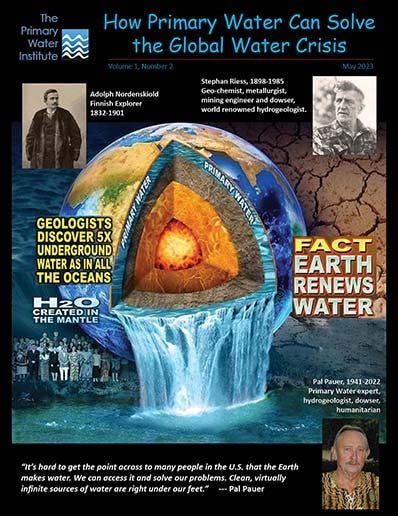
(With many thanks to Joel)






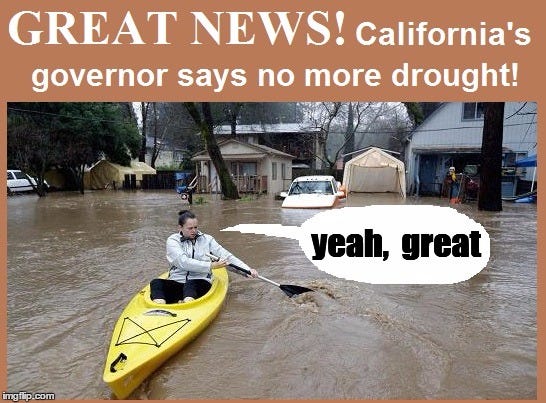


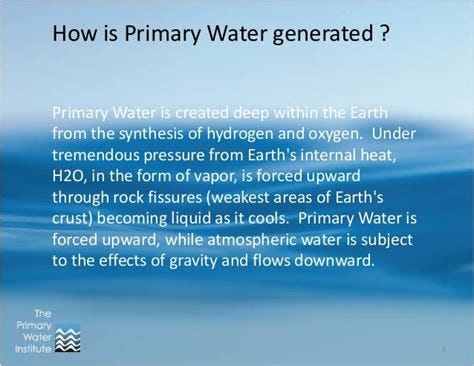
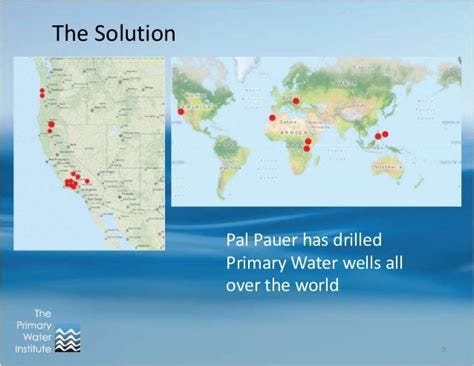
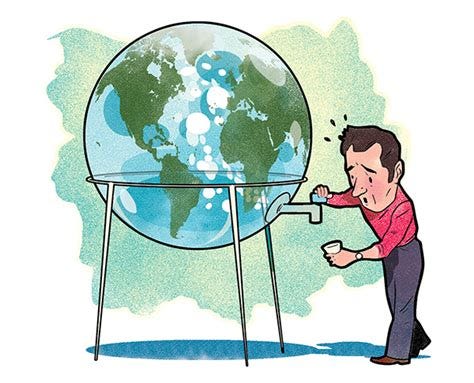


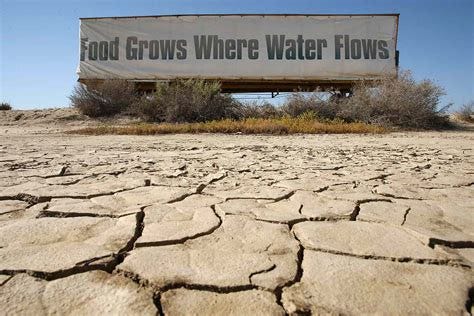





Let those who have bought the lie, that we supposedly live in a world of scarcity, read these articles and open their minds.
May our consciousness be expanded when we realize that we live in a divinely-ordered universe of abundance, seemingly organized for our benefit:
1. Anhydride Theory of oil, produced spontaneously by geological forces within our planet.
Conclusion: we could have abundant oil.
2. Primary Water, produced spontaneously by geological forces within our planet.
Conclusion: we could have abundant fresh water.
3. Zero Point Energy, produced spontaneously throughout the universe, as noted by Nicola Tesla, and many others, that can be tapped and utilized with the appropriate technology.
Conclusion: we could have inexpensive abundant energy to power our civilization.
The problem is not scarcity – rather, it is the deception that we live in a dead world of entropy and scarcity, rather than an ever-renewing world of cosmically-aligned, living abundance.
Here’s the link to a 3-page, 1934 “Original Affidavit” left behind as a tease forward to an, as yet, (publicly unrevealed) unsolved, PRIMARY WATER mystery :
http://www.kokoweef.com/Legend_Adobe_Acrobat_pdf/Earl-Dorr-Affidavit_Original.pdf
A tiny glimpse of my part in seeking the truth about this topic is found here : http://kokoweef.com/Ralph-Lewis-Files/Crystal-Cave-Kokoweef-Peak-Dorr-Lost-Mine.pdf
Hopefully, it can provide you at least some entertainment as an “armchair prospector” or into the greater, wondering pursuits of Creation’s life-sustaining PRIMARY WATER.
A series of Divine Synchronicities has brought me forward in life since 1952. It’s really no surprise in considering ALL of life is typically Divine and yet, for the most part, unseen, in our day-to-day humdrum of accumulated sNewZzzie headlies of fears, traumas and horrors resting in & on absolute foundations of LOVE’s watery Creation.
Since 1979, I’ve been “chased by a legend” about an ALLEGED underground river claimed to be flowing 1 mile below the High Deserts of Nevada and California. For better-or-worse, it harbors a tale along-side a “funny yellow metal” which mostly serves to distract “treasure morons” with a “gimME the gold, first” motive rather than a pursuit of finding to share Truths-first ; a more kind, more objective, more peaceful Truth-Seeking … for sharing.
Pure water is far more valuable than “all that legend’s unseen gold.” Well, that is, if any of it even exists at all. My advice is “Look for the truth FIRST” and, as my 2nd grade teacher in rural Vermont told us in her melodious, lovely voice, “Now class, always ask questions.”